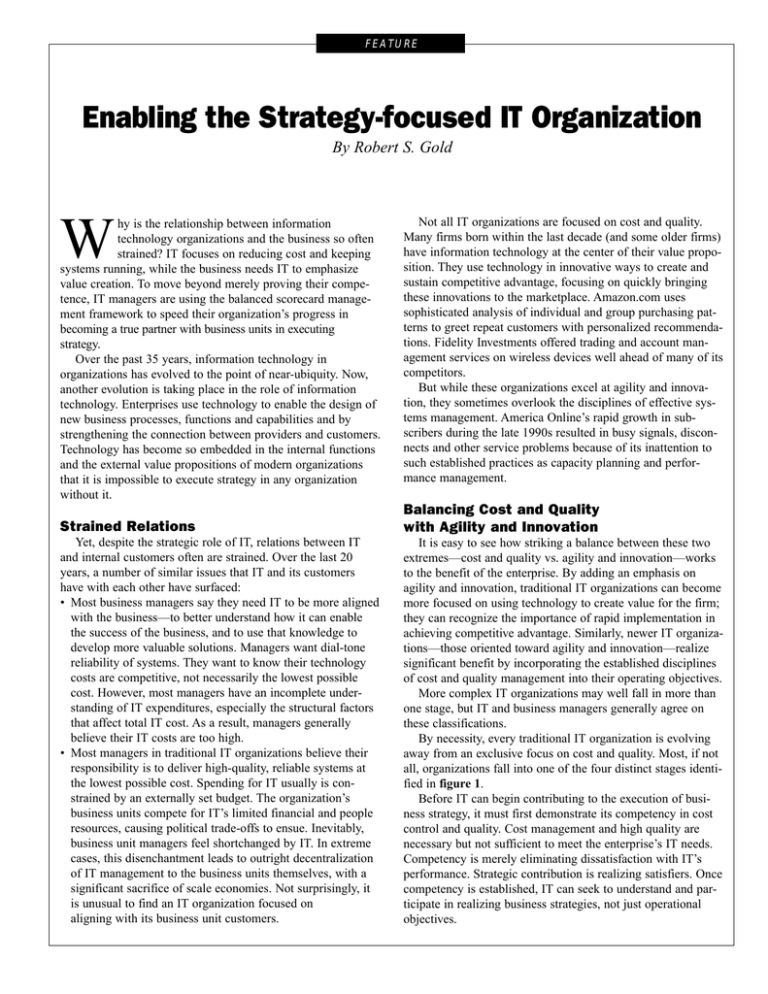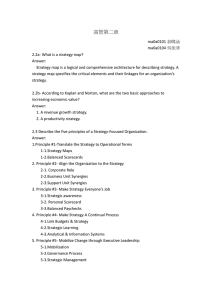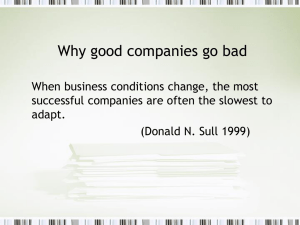W
advertisement

F E AT U R E Enabling the Strategy-focused IT Organization By Robert S. Gold W hy is the relationship between information technology organizations and the business so often strained? IT focuses on reducing cost and keeping systems running, while the business needs IT to emphasize value creation. To move beyond merely proving their competence, IT managers are using the balanced scorecard management framework to speed their organization’s progress in becoming a true partner with business units in executing strategy. Over the past 35 years, information technology in organizations has evolved to the point of near-ubiquity. Now, another evolution is taking place in the role of information technology. Enterprises use technology to enable the design of new business processes, functions and capabilities and by strengthening the connection between providers and customers. Technology has become so embedded in the internal functions and the external value propositions of modern organizations that it is impossible to execute strategy in any organization without it. Not all IT organizations are focused on cost and quality. Many firms born within the last decade (and some older firms) have information technology at the center of their value proposition. They use technology in innovative ways to create and sustain competitive advantage, focusing on quickly bringing these innovations to the marketplace. Amazon.com uses sophisticated analysis of individual and group purchasing patterns to greet repeat customers with personalized recommendations. Fidelity Investments offered trading and account management services on wireless devices well ahead of many of its competitors. But while these organizations excel at agility and innovation, they sometimes overlook the disciplines of effective systems management. America Online’s rapid growth in subscribers during the late 1990s resulted in busy signals, disconnects and other service problems because of its inattention to such established practices as capacity planning and performance management. Strained Relations Balancing Cost and Quality with Agility and Innovation Yet, despite the strategic role of IT, relations between IT and internal customers often are strained. Over the last 20 years, a number of similar issues that IT and its customers have with each other have surfaced: • Most business managers say they need IT to be more aligned with the business—to better understand how it can enable the success of the business, and to use that knowledge to develop more valuable solutions. Managers want dial-tone reliability of systems. They want to know their technology costs are competitive, not necessarily the lowest possible cost. However, most managers have an incomplete understanding of IT expenditures, especially the structural factors that affect total IT cost. As a result, managers generally believe their IT costs are too high. • Most managers in traditional IT organizations believe their responsibility is to deliver high-quality, reliable systems at the lowest possible cost. Spending for IT usually is constrained by an externally set budget. The organization’s business units compete for IT’s limited financial and people resources, causing political trade-offs to ensue. Inevitably, business unit managers feel shortchanged by IT. In extreme cases, this disenchantment leads to outright decentralization of IT management to the business units themselves, with a significant sacrifice of scale economies. Not surprisingly, it is unusual to find an IT organization focused on aligning with its business unit customers. It is easy to see how striking a balance between these two extremes—cost and quality vs. agility and innovation—works to the benefit of the enterprise. By adding an emphasis on agility and innovation, traditional IT organizations can become more focused on using technology to create value for the firm; they can recognize the importance of rapid implementation in achieving competitive advantage. Similarly, newer IT organizations—those oriented toward agility and innovation—realize significant benefit by incorporating the established disciplines of cost and quality management into their operating objectives. More complex IT organizations may well fall in more than one stage, but IT and business managers generally agree on these classifications. By necessity, every traditional IT organization is evolving away from an exclusive focus on cost and quality. Most, if not all, organizations fall into one of the four distinct stages identified in figure 1. Before IT can begin contributing to the execution of business strategy, it must first demonstrate its competency in cost control and quality. Cost management and high quality are necessary but not sufficient to meet the enterprise’s IT needs. Competency is merely eliminating dissatisfaction with IT’s performance. Strategic contribution is realizing satisfiers. Once competency is established, IT can seek to understand and participate in realizing business strategies, not just operational objectives. Figure 1—Evolutionary Stages in the Development of IT Organizations Basic Competency Focus Stage I. Defensive II. Reactive III. Responsive IV. Strategy-focused Costs • IT expenditures are externally budgeted, often as share of revenue. • Service level agreements and charge-back systems are employed. • Unit costs and demand are quantified and managed. • Technology investment decisions are informed by business strategy. Strategic Contribution Focus Quality • Quality focus is exclusively on system availability. • Quality focus is on system availability and response time. • Quality is managed to negotiated service level agreements. • Availability and reliability are no longer an issue. Agility Innovation • Delivery schedules are constrained by resources and internal priorities. • Resource allocation is driven by politics. • Creative budgeting and accounting are used to defend against outsourcing. • Technologies are used in innovative ways to reduce IT cost. • Methods are applied to reduce development cycle time. • Broad focus is on time to market and competitive advantage for the business. • The role of technology in business strategy is considered. • Technology is embedded in the firm’s value proposition. More complex IT organizations may well fall in more than one stage, but IT and business managers generally agree on these classifications. Not surprisingly, there is a gap between how IT views itself and how business managers view it. (Shows of hands taken by the author at public conferences indicate that IT managers generally see their organizations at the responsive stage, while business unit managers generally see their IT organizations as merely reactive.) IT managers and their business unit customers do agree on one thing: IT must become focused on strategy. The Strategy-focused IT Organization Since its introduction in 1992, the balanced scorecard management framework has been used by hundreds of organizations worldwide to describe enterprise strategy and measure strategic performance. First described by Drs. Robert Kaplan and David Norton in a series of articles in Harvard Business Review1 and later elaborated in two books,2 the balanced scorecard augments traditional financial measures of performance with measures from the perspective of customers, business processes and key intangible enablers, such as human resources, information technology, intellectual capital and enterprise culture. By carefully selecting performance measures for a concise set of strategic objectives, firms have achieved dramatic improvement in overall performance.3 A balanced scorecard enables strategy focus in IT organizations by creating a shared language for performance between IT and its business unit customers. Scorecard measures communicate IT’s competence in delivering competitive cost and meeting service quality objectives. IT’s strategy map establishes that it has a strategy distinct from that of the business units and clearly shows how IT’s strategy is aligned with the success of business units. A key component of the balanced scorecard framework is the strategy map. On a single page, the strategy map communicates an organization’s strategy and the processes and systems that enable it to implement that strategy. The map describes how value is created through strategic objectives linked in a series of cause and effect relationships.4 Figure 2 offers a strategy map template for a generic IT organization. From the financial perspective of enterprise management, IT is simply a means for accomplishing the strategy of the business units and, by extension, the enterprise itself. The optimal use of IT resources—to maximize value creation by the business units—is distinct from the traditional goal of controlling IT expenditure. In progressive organizations, the financial emphasis is not on reducing overall IT expenditure, but rather on understanding and managing the unit costs of IT resources, as well as on predicting demand, which together ease the traditional budgetary constraints on IT investment. Establishing the value-creating potential of IT helps business managers (and senior management) recognize the difference between IT investment and IT expense. Figure 2—Strategy Map Template for an IT Organization The strategy map also expresses IT’s need to balance its focus on both competency and contribution. From the perspective of IT’s primary customer, the business unit manager (BUM), IT competency means quality service and competitive cost, while IT contribution refers to both the implicit benefit of IT on the productivity of the business unit and the explicit achievement of business unit strategies. Agility and innovation are embedded in the BUM’s definition of achieving strategy. But to deliver on the customer’s expectations, everyone within the IT organization needs to embrace the balanced themes of competency and contribution. Treacy and Wiersema’s model5 guides the organization of IT internal activities in several IT organizations. The Operational Excellence objectives within the internal business process perspective of the strategy map reflect the IT organization’s commitment to deliver competitive unit costs and quality service. The centralized IT organization exists to realize scale economies by aggregating and optimizing standardized resources and processes. By achieving these objectives, IT’s credibility increases, permitting the organization to shift its orientation outward to its customers. The business unit alliance component reflects a new focus on productivity in the business unit itself. By setting and meeting deadlines for the delivery of services and new functions, by ensuring that end users have access to effective support and by understanding the way the business works, IT earns the opportunity to participate in creating and executing strategy as a true partner of the business unit. True Solutions Leadership results from IT’s intimate understanding of the business unit’s value proposition and valuecreating processes, along with its proactive thinking about the practical application of emerging technology. Increasingly, business value-creating opportunities and solutions will originate in the strategy-focused IT organization. Strategy-focused IT depends on having the right people and the right climate in which they perform. Intense competition for people with leading-edge skills necessitates an explicit focus on staff development and retention that is often absent from IT organizations that are focused only on reducing cost. recognize IT must evolve from being a cost-focused service provider to a partner in value creation will actively promote this evolution—and enjoy significant advantage. (Portions of this article first appeared in Balanced Scorecard Report, published by Harvard Business School Publishing and Balanced Scorecard Collaborative.) A Starting Point Robert S. Gold is practice leader for information technology at Balanced Scorecard Collaborative, where he applies the balanced scorecard framework to enable the emergence of strategyfocused IT organizations. In more than 12 years of IT management consulting, Gold has advised such clients as DaimlerChrysler, Ford, IBM, Exxon-Mobil, Caterpillar, Disney, Texas Instruments, Anheuser Busch, Target, EDS, Hallmark, Morgan Stanley and T. Rowe Price in the disciplines of strategic alignment, performance improvement, operations management and continuity planning. Gold earned his MBA in management strategy and organization behavior at Northwestern University’s (USA) Kellogg School of Management. He is a frequent speaker at industry conferences and often has been published in IT industry publications. Every IT organization faces unique challenges, and the template presented here is just a starting point for facilitating the evolution toward a strategy-focused IT organization. This approach to developing IT balanced scorecards begins with the formation of a small team of key IT managers, business unit managers, and senior enterprise executives. It uses their input to create a strategy map, and then to select measures that capture the unique objectives of the enterprise and its IT organization. It then facilitates the selection of measures for each of the objectives, and establishes targets for each measure. A clear picture of strategic alignment of IT emerges with the evaluation of the initiatives underway in IT against the strategic objectives. Inevitably, some objectives are not yet supported by any initiatives, and initiatives that do not support strategic objectives may be found. The rate at which information technology is enabling value creation varies by industry, even by company. Firms that Endnotes Kaplan, Robert S. and David P. Norton, “The Balanced Scorecard—Measures that Drive Performance,” Harvard Business Review, January - February 1992 Kaplan, Robert S. and David P. Norton, “Putting the Balanced Scorecard to Work,” Harvard Business Review, September October 1993 Kaplan, Robert S. and David P. Norton, “Using the Balanced Scorecard as a Strategic Management System,” Harvard Business Review, January - February 1996 2 Kaplan, Robert S. and David P. Norton, The Balanced Scorecard, Boston, Harvard Business School Press, 1996 Kaplan, Robert S. and David P. Norton, The Strategy-Focused Organization, Boston, Harvard Business School Press, 2000 3 For examples of companies achieving breakthrough results with balanced scorecards, visit www.bscol.com. 4 Kaplan, Robert S. and David P. Norton, “Having Trouble with Your Strategy? Then Map It,” Harvard Business Review, September - October 2000 5 Treacy, Michael and Fred Wiersema, The Discipline of Market Leaders, Reading, MA, Perseus Books, 1995. This important work begins with the premise that firms achieve competitive advantage by going to market with an emphasis on one of three value disciplines: operational excellence, customer intimacy or product leadership. While Treacy and Wiersema contend that a firm must achieve only a satisfactory level of performance in its two nonfocus areas, IT’s competitive landscape is different. In exchange for its monopoly or preferred provider status within the enterprise, IT must excel in all three disciplines (operational excellence, business unit alliance and solutions leadership) to maximize the valuecreating potential of its business unit customers. 1





